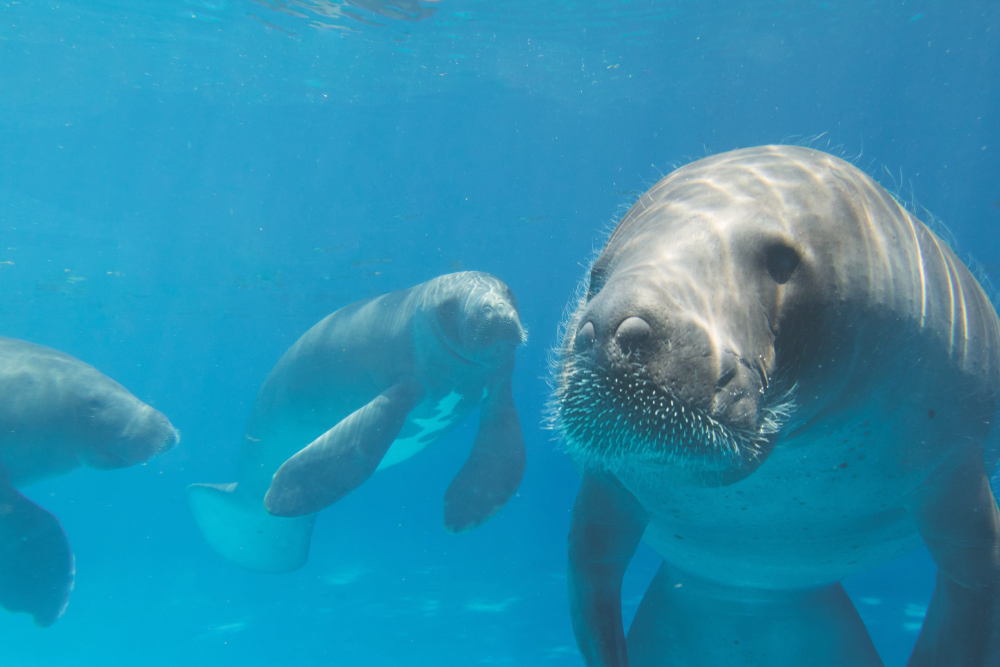The Amazonian manatee (Trichechus inunguis), often called the “sea cow,” is a fascinating and gentle mammal residing in the freshwaters of the Amazon Basin. Distinguished by its serene nature and unique adaptations to its environment, the Amazonian manatee plays a crucial role in the ecosystem. This article explores the biology, habitat, behavior, conservation status, and the importance of this remarkable creature.
Biology and Physical Characteristics
The Amazonian manatee is one of three species of manatees, belonging to the order Sirenia. It is the smallest of the manatee species, typically measuring between 2.8 to 3 meters (9 to 10 feet) in length and weighing around 350 to 500 kilograms (770 to 1,100 pounds). Unlike its relatives, the West Indian and African manatees, the Amazonian manatee lacks nails on its flippers, a unique characteristic that aids in its identification.
These aquatic mammals have a streamlined, torpedo-shaped body adapted for an aquatic lifestyle. Their skin is thick and wrinkled, covered in fine hairs that are more sensitive than they appear. Their coloration ranges from gray to brown, often with a lighter patch on their bellies. They have small, prehensile flippers which they use for maneuvering, feeding, and social interaction. The manatee’s tail is paddle-shaped, aiding in propulsion through the water.

Habitat and Distribution
The Amazonian manatee is exclusively found in the freshwater systems of the Amazon Basin, which includes rivers, lakes, and flooded forests across countries like Brazil, Peru, Colombia, and Ecuador. They prefer slow-moving waters with abundant aquatic vegetation, which constitutes their primary diet. The seasonal flooding of the Amazon River creates a dynamic habitat, providing extensive feeding grounds during the rainy season when vast areas are submerged.
During the dry season, manatees retreat to deeper parts of the river and lakes to avoid the dwindling water levels. This seasonal movement is essential for their survival, as it ensures access to both food and suitable water depth throughout the year.
Behavior and Diet
Amazonian manatees are herbivorous, feeding primarily on a variety of aquatic plants, including grasses, floating vegetation, and submerged plants. An adult manatee can consume up to 10% of its body weight in vegetation daily. This feeding habit plays a critical role in maintaining the health of the aquatic ecosystem, as it helps control plant growth and ensures a balanced environment for other species.
These gentle giants are generally solitary, although they can be seen in small groups, particularly mothers with their calves. Manatees communicate through vocalizations, including chirps, whistles, and squeaks, which are essential for maintaining social bonds, especially between mothers and offspring.
Reproduction in Amazonian manatees is slow. Females typically give birth to a single calf after a gestation period of about 12 to 14 months. Calves are dependent on their mothers for up to two years, during which they learn crucial survival skills, including finding food and navigating the waterways.
Conservation Status
The Amazonian manatee is classified as “Vulnerable” by the International Union for Conservation of Nature (IUCN). Despite their elusive nature and the vastness of their habitat, they face significant threats from human activities. Hunting for their meat and oil has historically been a major threat, although it has declined due to legal protections and conservation efforts.
However, habitat destruction remains a critical issue. Deforestation, pollution, and the construction of dams disrupt the delicate balance of the aquatic ecosystem, reducing the availability of food and suitable habitats. Additionally, accidental entanglement in fishing nets poses a significant risk to their population.
Conservation Efforts and Importance
Efforts to conserve the Amazonian manatee focus on habitat protection, anti-poaching measures, and community education. Several protected areas have been established within the Amazon Basin to safeguard critical habitats. Conservation organizations are also working to rehabilitate injured manatees and reintroduce them into the wild.
Community involvement is crucial for the success of conservation initiatives. Education programs aim to raise awareness about the importance of manatees and promote sustainable practices among local communities. By involving residents in conservation activities, such as monitoring manatee populations and reporting illegal activities, these programs help foster a sense of stewardship and responsibility towards these gentle creatures.
The Amazonian manatee plays a vital role in its ecosystem. By feeding on aquatic vegetation, they help maintain water quality and promote the growth of diverse plant species, which benefits other aquatic organisms. Their presence indicates a healthy, functioning ecosystem, making them an important species for monitoring environmental health.
Conclusion
The Amazonian manatee is a symbol of the rich biodiversity of the Amazon Basin. Despite facing numerous threats, ongoing conservation efforts provide hope for their future. Protecting the Amazonian manatee not only ensures the survival of this unique species but also preserves the intricate balance of the ecosystem they inhabit. As we continue to learn more about these gentle giants, it is crucial to promote and support initiatives that safeguard their habitat and foster coexistence with local communities. Through concerted efforts, we can ensure that the Amazonian manatee remains a thriving part of the natural world for generations to come.









